Excerpts from Jim Conrad's
Naturalist Newsletter
entry dated March 30, 2022, issued from near Tequisquiapan, elevation about 1,900m (6200 ft), ~N20.57°, ~ W99.89°, Querétaro state, MÉXICO
PINENEEDLE MILKWEED
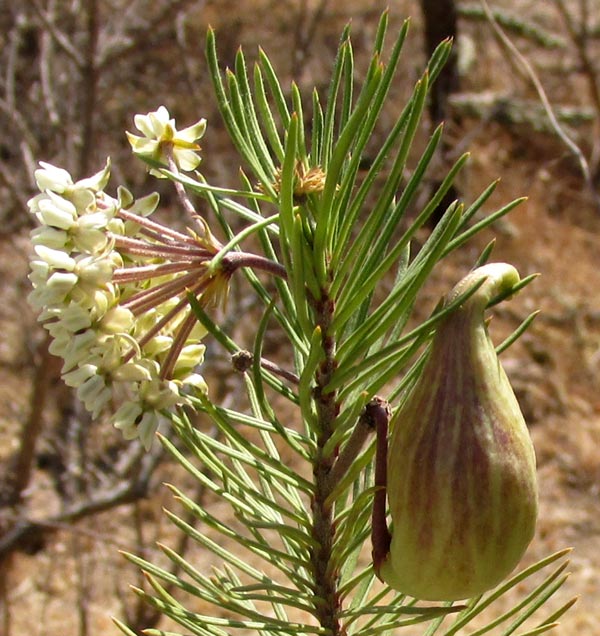
The above picture-perfect arrangement of flowers, fruit and spruce-like leaves on a woody stem turned up in a fenced-in area more protected than usual from this area's ubiquitously wandering, herder-attended, small herds of cattle, sheep and goats. The very distinctive flowers and capsular-type fruit are unmistakably those of one of the over 200 species of the world's milkweeds, genus Asclepias. Until recently milkweeds were assigned to their own family, the Milkweed Family, the Asclepiadaceae, but now with gene sequencing that family has been demoted, to become a subfamily of the Dogbane Family, the Apocynaceae.
Most milkweeds are herbaceous, but this waist-high plant was like a sprawling bouquet of limber but woody branches of a needle-bearing but mostly defoliated spruce tree, shown below:
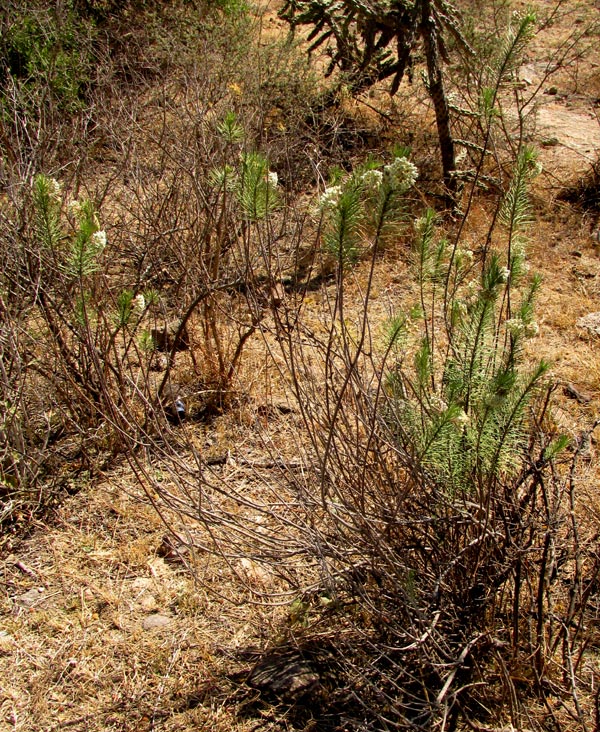
Most milkweed species also bear flat leaves not at all needle-like. However, the flowers on our needle-producing plant were completely typical of the milkweeds, as seen below:

In evolutionary terms, the milkweeds are a more recently arisen group, and this is reflected in the astonishing structure of their flowers. Milkweed flowers have developed a very unusual pollination strategy, with the flowers facilitating that strategy. You may be interested in reviewing our special milkweed flower page. On that page you can see that the five structures in the above picture looking like white shoes on tiptoe are "corona limbs," or "hoods." The limbs as a unit are referred to as the "corona" inside which arise fingerlike "horns." The corona limbs encircle a pale object called the "gynostegium," which consists of the flower's fused-together stigma and anthers. That's mind-boggling in itself, since in normal flowers stigmas are the female part where pollen germinates, and anthers are the male baglike thing producing pollen, and are kept apart. Along the gynostegium's side, the dark things appearing between the limbs are "pollinaria," each bearing two "pollinia," which are tiny, stuck-together pollen grains. On our milkweed page there's a picture of a pollinarium with its pollinia.
When an insect's leg catches between the corona limbs, the leg snags on the pollinarium, the insect then carries away the pollinarium with its pollinia. Orchids, also a modern evolutionary invention, also produce pollinaria, even though they're only very distantly related to milkweeds. It's a brilliant solution arrived at by two different plant groups, and an example of parallel evolution. The main problem with this sophisticated system is, what happens to the plants when their pollinating species no longer come to pollinate? This question is in the context of the vast numbers of pollinator species facing extinction. Below you can see a flower from the side, with a pollinarium between the corona limbs, awaiting pick-up service.
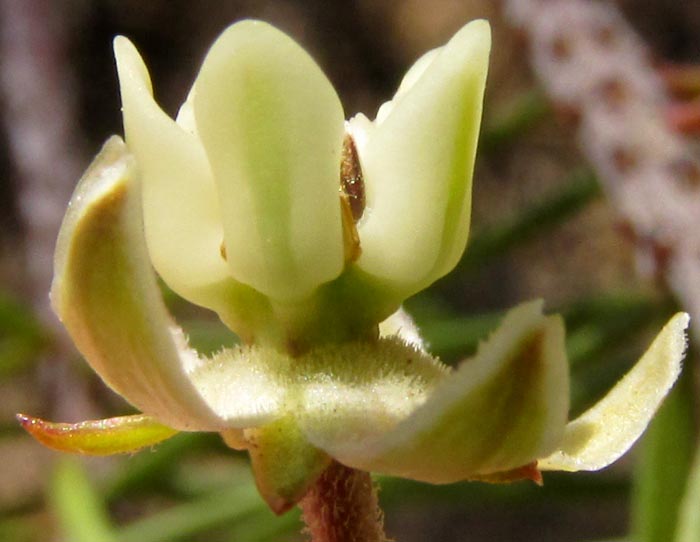
Knowing the genus in advance, and having such an unusual species, it was easy to identify this shrub as what is often called the Pineneedle Milkweed, ASCLEPIAS LINARIA. Its English name is explained by its occurrence in deserty southern Califoria, Arizona and New Mexico. However, most of its distribution area is in arid, upland Mexico south to the Mexico City area. It favors arid scrub, oak-pine forests, and certain least-disturbed disturbed areas.
Probably all milkweed species have been used traditionally as medicine, if only because when their tissue is wounded, it "bleeds" a thick latex, nearly always white. This latex contains cardiac glycosides, which may be toxic or medicinal, depending on the dosage. In Mexico our Pineneedle Milkweed has been documented as used as a purgative, and for skin conditions ranging from cuts to infections, and to remove wrinkles.
Entry dated November 7, 2023, from notes taken at Cascadas de La Piedad waterfall 3kms NW of the community of San Pablo, municipality of Almeaco de Bonfil; bedrock of igneous andesite; N20.1008°, W100.0041°, elevation 2360 meters (7750ft); extreme southern Querétaro state, MÉXICO
LERINA INCARNATA CATERPILLAR ON ASCLEPIAS LINARIA
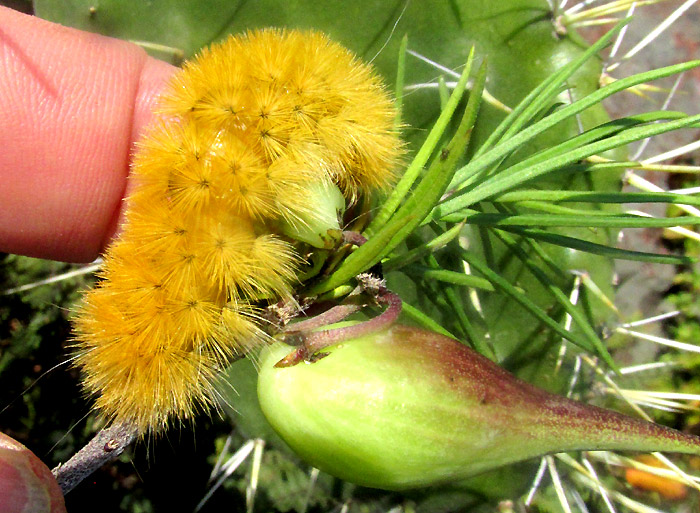
In thin soil atop pinkish, igneous andesite rock at the edge of the canyon formed a little downstream from the Cascada de La Piedad, or Piety Waterfall, the above caterpillar perched unmoving atop a knee-high, fruiting Asclepias linaria. Knowing how difficult it is to identify caterpillars where no illustrated field guides are available, usually I pass by them. However, this time, two features of what's seen above suggested that this one might be easier to identify.
First, the caterpillar's size and hairiness was similar the caterpillars of the Isabella Tiger Moth, Pyrrharactia isabella. Maybe on the Internet mention could be found of species closely related to that species.
Secondly, the plant on which the caterpillar evidently had been feeding was Asclepias linaria; it grew abundantly thereabouts. This was interesting because milkweeds contain chemical toxins known as cardenolides, which prevent most animals from eating them. However, the 2015 study by Gail Morris and others entitled "Status of Danaus plexippus in Arizona," lists Pineneedle Milkweed as a host for Monarch Butterfly caterpillars. Since few caterpillar species other than those of Monarchs feed on milkweeds, maybe that would help during the identification process.
In case it also would help with identification, a close-up of hair tufts was taken:
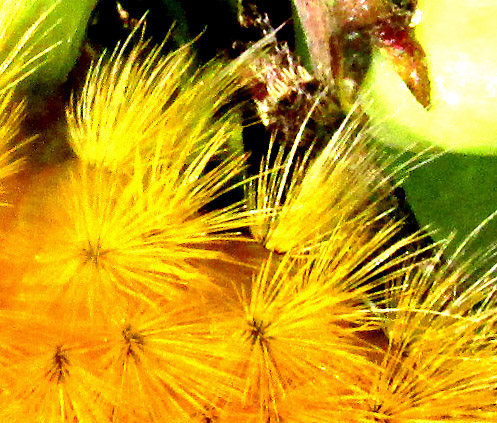
Pyrrharactia isabella belongs to the large moth family Erebidea. On the GBIF.Org world map displaying georeferenced records of Erebedae species, I zoomed in on our part of highland central Mexico and clicked on the "explore area" link. This brought forth a list of maybe a hundred documented observations of around 20 different species seen in our area. Searching for images of each listed species, eventually matching pictures popped up, identified as Lerina incarnata.
However, there might be more than one fuzzy, yellowish caterpillar in our area, so now I searched for web pages associating Lerina incarnata with Asclepias species. The Bugguide.Com page for Lerina incarnata resulted, where the only food listed for the species was the Pineneedle Milkweed -- exactly the plant on which our caterpillar was perched.
Therefore, I'm confident in calling our caterpillar LERINA INCARNATA, whose adult moth form is known as the Crimson-bodied Lichen Moth. Crimson-bodied Lichen Moths are distributed from arid southeastern Arizona in the US south through the uplands of Mexico to about Oaxaca.
Apparently Lerina incarnata is an unusual moth, for it's the only species assigned to the genus Lerina.
However, this appears to be one of those species which appears on numerous lists, and is photographed fairly frequently, but about which hardly anything is known, other than its caterpillars feed on Pineneedle Milkweed.